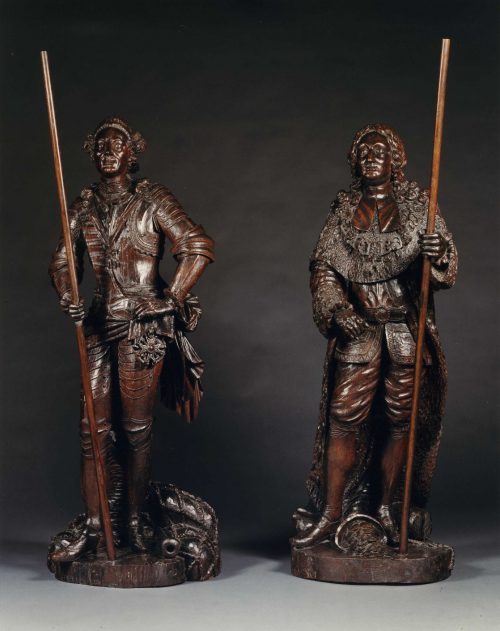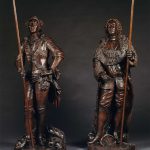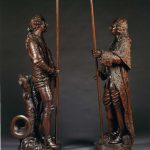9542 A PAIR OF CARVED OAK FIGURES DEPICTING KURFURST FERDINAND MARIA AND KURFÜRST MAXIMILIAN III JOSEPH, ELECTORS OF BAVARIA, POSSIBLY BY FRANZ SCHEUCHER Munich. Circa 1780-90 Measurements: Figure 1: Width: 25 1/4″ (64cm) Depth: 21″ (53cm) Height: 66 1/4″ (168cm) Figure 2: Width: 22 1/2″ (57cm) Depth: 22 1/2″ (57cm) Height: 66 1/4″ (168cm)

Research
Of oak. Each carved figure on a shallow oval plinth, the figure depicting Kurfürst Ferdinand Maria dressed in the ermine trimmed coat of an elector of the Holy Roman Empire, a bag of coins at his feet, the figure depicting Kurfürst Maximilian III Joseph dressed in princely armour with musical pipes at his feet.
The figures in this remarkable pair represent two notable members of the ancient Bavarian ducal line of Wittelsbach, Kurfürst Ferdinand Maria (1651 – 1679) and Kurfürst Maximilian III Joseph (1745 – 1777).
Ferdinand Maria was the son of the first Bavarian Prince-Elector, Maximilian I. Under his rule the power of the Wittelsbachs was strengthened via closer political involvement with France, and French splendour brought to the Bavarian court.1 Ferdinand Maria was also the founder of the magnificent Nyphemburg Palace in Munich, built in gratitude to his wife, Henriette Adelaide, who after ten years of marriage bore them their first son in 1662.2
Maximilian III Joseph was the son of Kurfürst Karl Albrecht and Princess Maria Amelia of Austria. The last Prince-Elector of Bavaria, he was a committed enlightenment ruler, ending conflict with Austria by signing the Treaty of Füssen in 1745 and establishing an education system for his subjects.3
He was also an enthusiastic supporter of the arts, especially music, and through his passion he added to the splendours of Nymphenburg, which by the mid-eighteenth century had expanded into a palace to rival Versailles. A fresco in the Nymphenburg Palace by Johann Baptist Zimmerman celebrating the Kurfürst depicts the dawning of a cultural Golden Age. In 1750 he commissioned the magnificent Old Residence Theatre from one of the principal exponents of rococo design, François Cuvillés, where thirty years later Mozart’s opera Idomeneo had it world premier.4 His musical persuits are represented here by the musical pipes at his feet.
The regailia of the present figures is in-keeping with their noble rank. Both wear the Order of the Golden Fleece, the figure of Ferdinand Maria displaying it on an ornate collar, that of Maximilian III Joseph showing it on a ribbon around the neck. The likeness of Maximilian III Joseph also wears the badge of the order of St. George, awarded to Roman Catholics of noble birth for services to the State. Both orders are frequently depicted in portraits of the Wittelsbach Dukes.5 The emine trimmed coat of an Elector of the Holy Roman Empire and princely armour worn by the figures further indicate their elevated status.
The figures were almost certainly part of a larger group, in the tradition of the series of bronzes in Innsbruck by the 16th century sculptor Leonhardmagt.6 Their subject matter and fine workmanship suggest they would have been placed in a prominent position, for example in a princely interior. On them can be found minute traces of white ‘stone’ paint, indicating that the figures were probably painted to imitate marble.
Given the rarity of this type of figure it is significant that four other wooden sculptures of Bavarian Electors of a similar size are known to exist. Three of these examples, including one at the Germanisches National Museum, Nuremberg, are known to be by the Tyrolean sculptor Franz Scheucher (1756 – 1803)7. Two of the three are signed and dated 1790.8 The catalogue of the Germanisches National Museum states that its figure, which also retains traces of painted decoration and is raised on a carved fluted column, was originally part of a larger group of eighteen figures of rulers of the house of Wittlesbach.9 This group may well have included the present pair.10
The present figures have an extraordinary provenance, illustrating the dramatic history of one of Europe’s leading dynasties. Formerly in the collection of Empress Eugenie (1826-1920), wife of Emperor Napoleon III, the figures probably came into the possession of the French Imperial family via the marriage of Eugène Rose de Beuharnais, son of Josephine de Beuharnais and adopted son on Napoleon I, to the Wittelsbach princess Augusta Amalia Ludovika Georgia of Bavaria in 1806.
After the fall of the Empire in 1870, the Emperor and Empress were forced to flee to England. In exile, they set up home at Camden House, Kent, from which a number of items, including these figures were sold by auction after the death of Napoleon III in 1873.
Footnotes:
1. R. Babel ‘The Courts of the Wittelsbachs c.1500 – 1750’ in J. Adamson, ed., The Princely Courts of Europe: 1500 – 1750, London, Severn Dials, 2000, p. 193.
2. P. Krückmann, The Wittelsbach Palaces, London, Prestel, 2001, p. 36.
3. P. Krückmann, The Wittelsbach Palaces, London, Prestel, 2001, p. 40.
4. P. Krückmann, The Wittelsbach Palaces, London, Prestel, 2001, p. 38, 40.
5. Sotheby’s, Amsterdam, 18th, 19th, 20th Feb 2003, p. 204.
6. Sotheby’s, London, 11/12/1986.
7. E. Benezit, Dictionnaire Des Peintres, Sculpteurs, Dessinateurs et Graveurs, vol. 9, Paris, Grund, 1976, p.356.
8. Sotheby’s, London, 11/12/1986.
9. Information from www.hdbg.de (Haus de Bayerischen Geschichte)
10. The fourth known carved wooden figure represents Kurfürst Charles Albert (1726 – 1745), Sotheby’s, New York, 25/4/1986.


Comments are closed.